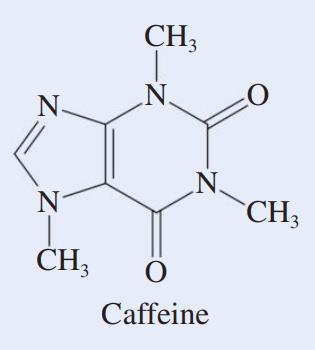Question 16.17: Caffeine, the stimulant in coffee and tea, is a weak base th...
Caffeine, the stimulant in coffee and tea, is a weak base that ionizes in water according to the equation
\text{C}_8\text{H}_{10}\text{N}_4\text{O}_2(aq) + \text{H}_2\text{O}(l) \rightleftarrows \text{HC}_8\text{H}_{10}\text{N}_4\text{O}_2^+(aq) + \text{OH}^–(aq)
A 0.15-M solution of caffeine at 25°\text{C} has a \text{pH} of 8.45. Determine the K_b of caffeine.

Strategy Use \text{pH} to determine \text{pOH}, and \text{pOH} to determine the hydroxide ion concentration. From the hydroxide ion concentration, use reaction stoichiometry to determine the other equilibrium concentrations and plug those concentrations into the equilibrium expression to evaluate K_b.
Setup
\text{pOH} = 14.00 − 8.45 = 5.55
[\text{OH}^–] = 10^{–5.55} = 2.82 × 10^{–6} M
Based on the reaction stoichiometry, [\text{HC}_8\text{H}_{10}\text{N}_4\text{O}_2^+] = [\text{OH}^–], and the amount of hydroxide ion in solution at equilibrium is equal to the amount of caffeine that has ionized. At equilibrium, therefore,
[\text{C}_8\text{H}_{10}\text{N}_4\text{O}_2] = (0.15 − 2.82 × 10^{–6}) M ≈ 0.15 M
\text{C}_8\text{H}_{10}\text{N}_4\text{O}_2(aq) + \text{H}_2\text{O}(l) \rightleftarrows \text{HC}_8\text{H}_{10}\text{N}_4\text{O}_2^+(aq) + \text{OH}^–(aq)
| Initial concentration (M): | 0.15 | 0 | 0 | |
| Change in concentration (M): | –2.82 × 10^{–6} | +2.82 × 10^{–6} | +2.82 × 10^{–6} | |
| Equilibrium concentration (M): | 0.15 | 2.82 × 10^{–6} | 2.82 × 10^{–6} |
Learn more on how we answer questions.
Plugging the equilibrium concentrations into the equilibrium expression gives
K_b =\frac{[\text{HC}_8\text{H}_{10}\text{N}_4\text{O}_2^+][\text{OH}^–]}{[\text{C}_8\text{H}_{10}\text{N}_4\text{O}_2]} = \frac{(2.82 × 10^{–6})^2}{0.15} = 5.3 × 10^{–11}